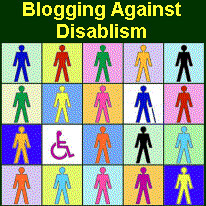[This post was originally published on October 3, 2008 at Hoyden About Town.]
*trigger warnings apply to this post: descriptions of abuse and sexual assault against women with disabilities**
“This young woman [“Caroline”] has cerebral palsy, is wheelchair bound, totally dependent on carers for her personal and daily living activities, and non-verbal. Cognitively very aware, she depends on assisted communication to enable her to communicate … Caroline was sexually assaulted by the taxi driver who picked her up from home and drove her to school …
Caroline uses a communication book to communicate, but her communication book did not have the vocabulary she needed to describe what had happened to her. Her communication book did not include words such as “penis” or “rape”, and police would not allow these words to be added after the incident, because as the police explained, in court this would be seen as leading the witness. (Excerpt from an interview with a support worker cited in Federation of Community Legal Centres, 2006, pp. 7–8).”
Suellen Murray and Anastasia Powell of the Australian Centre for the Study of Sexual Assault have just released a new report: “Sexual assault and adults with a disability enabling recognition, disclosure and a just response” [PDF].
This report starts to fill a huge gap in our knowledge of sexual violence in Australia. Although data in North America has shown that women with disabilities (WWD) are far more likely to experience sexual violence than those without, up until now there has been little or no systematic research into what is happening with WWD in Australia:
Despite being the major national data collection regarding the status and experiences of adults with a disability, the ABS Survey of Disability, Ageing and Carers, does not invite participants to report on their experiences of violence or abuse.
Similarly, the ABS (2006) Personal Safety Survey report, which specifically investigates experiences of violence, does not identify the disability status of participants, and the International Violence Against Women Survey (IVAWS) specifically excluded women with an illness or disability from the sample for the survey (Mouzos & Makkai, 2004).
Therefore, despite evidence that approximately 20% of Australian women, and 6% of men, will experience sexual violence in their lifetime (ABS, 2006), there is no standard national data collection that includes the experiences of sexual violence amongst adults with a disability, or more specifically, the experiences of women with a disability.
There is one smallish South Australian study showing that adults with intellectual disabilities are over ten times more likely to have been sexually assaulted.
Continue reading Barriers to justice when rapists attack women with disabilities: Australian report
